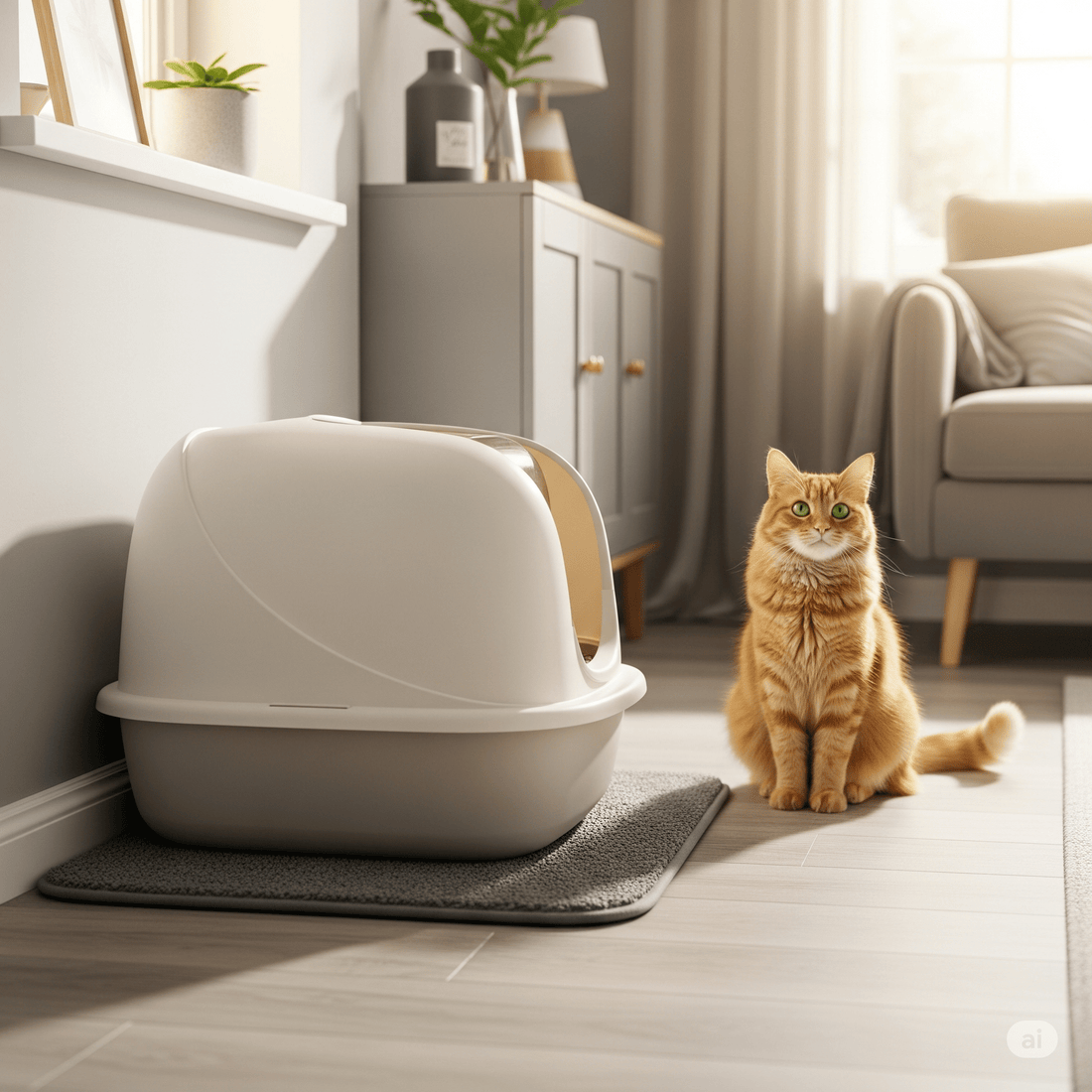
Setting Up the Perfect Litter Box Area for Your Cat
Share
Providing your feline companion with a litter box area that meets their specific needs is not merely a matter of convenience; it is a fundamental pillar of their health, happiness, and behavioral well-being within your home. A properly set up and maintained litter box environment can prevent a myriad of common feline behavioral issues, from inappropriate urination outside the box to stress-related ailments. Cats are inherently fastidious creatures with a deeply ingrained instinct for cleanliness and privacy when attending to their bodily functions, and neglecting these innate desires can lead to significant distress for both the cat and their human guardians. Understanding the subtle nuances of what constitutes a truly perfect litter box area requires thoughtful consideration of location, type of box, choice of litter, and a rigorous commitment to cleanliness, all working in harmony to create a space where your cat feels safe, secure, and inclined to do their business.

How Do You Create the Ideal Litter Box Sanctuary for Your Cat?
The placement of the litter box is perhaps the most critical decision, influencing whether your cat will readily accept and consistently use it. Cats require privacy and a sense of security when they are most vulnerable, making quiet, low-traffic areas ideal. Think about corners, discreet alcoves, or even designated utility spaces that are easily accessible to your cat but removed from the bustling activity of human foot traffic, loud appliances, or sudden noises. Avoid placing litter boxes near their food and water bowls, as cats are naturally averse to eating where they eliminate. Similarly, high-traffic thoroughfares like hallways, busy living rooms, or the immediate vicinity of noisy washing machines, dryers, or furnaces should be avoided at all costs. These locations can startle a cat, creating a negative association with the litter box and leading them to seek alternative, often undesirable, spots for elimination. The area should also be well-ventilated, not only to minimize odors but also to ensure a comfortable environment for your cat, yet without being drafty or overly exposed to cold air, which could deter them from entering. Accessibility is equally important; for kittens, senior cats, or those with mobility issues, the box must be easy to enter and exit, perhaps avoiding stairs if the cat has difficulty with them, or choosing a box with lower sides.
The number of litter boxes available to your cat is another crucial factor, especially in multi-cat households. The widely accepted rule of thumb is to provide one litter box per cat, plus one additional box (N+1 rule). This means if you have two cats, you should ideally have three litter boxes placed in different locations throughout your home. This strategy minimizes competition, offers alternative options if one box is occupied or perceived as unclean by a particular cat, and caters to individual preferences. Some cats may prefer to urinate in one box and defecate in another, or they might simply appreciate having choices. Placing these boxes in distinct areas helps to distribute the resources and prevent territorial disputes, ensuring each cat feels they have a private and readily available spot. Even for a single cat, offering two boxes can sometimes be beneficial, especially in larger homes, as it ensures a convenient option is always within reach, reducing the likelihood of accidents if the primary box is temporarily inaccessible or undesirable.

The physical attributes of the litter box itself significantly impact your cat's comfort and willingness to use it. When selecting a litter box, size matters immensely. Many commercially available litter boxes are simply too small for adult cats to comfortably turn around, dig, and cover their waste. A general guideline is that the litter box should be at least 1.5 times the length of your cat from nose to base of tail. Larger boxes offer more space for digging and maneuvering, making the experience more pleasant for your cat. Consider the depth as well; a deeper box allows for a sufficient layer of litter, which is essential for digging and covering, while still ensuring the entry point is manageable for your cat's size and mobility. The choice between an open litter box and a covered one is often debated. While covered boxes might appeal to human sensibilities by containing odor and litter scatter, many cats find them confining and less appealing. The enclosed space can trap odors, making the environment unpleasant for a cat's sensitive nose, and they can feel trapped or ambushed. Open litter boxes, conversely, provide better ventilation and an unobstructed escape route, which can make a cat feel more secure. Self-cleaning litter boxes, while convenient for owners, can also be off-putting to some cats due to the noise and movement of their automated cleaning cycles, which might be perceived as frightening or unpredictable. Some cats may even refuse to use them entirely.
The type of litter you choose is equally paramount to your cat's litter box acceptance. The vast majority of cats show a strong preference for fine-grained, unscented, clumping clay litter. This type of litter closely mimics the texture of sand, which is what cats would naturally use for elimination in the wild, and its clumping properties make scooping waste much easier, thereby maintaining cleanliness. Heavily scented litters, while designed to mask odors for humans, are often overwhelming and irritating to a cat's highly sensitive olfactory system. They can contain chemicals that cause respiratory irritation or make the litter box an unpleasant place to be. If you must use a scented litter, opt for very lightly scented versions or natural alternatives. Beyond traditional clay, other options include silica gel (crystal) litter, recycled paper pellets, pine pellets, corn, or wheat litters. Each has its pros and cons in terms of absorbency, odor control, and texture. If you are transitioning your cat to a new type of litter, do so gradually by mixing small amounts of the new litter with the old over several days or weeks, allowing your cat to acclimate to the new texture and smell. Observing your cat's reaction is key; if they suddenly stop using the box, the litter change could be the culprit.

Maintaining an impeccable cleaning routine is non-negotiable for a perfect litter box area. Cats are meticulously clean animals, and they are much less likely to use a dirty or odorous litter box. Scooping solid waste and urine clumps should ideally be done at least once, preferably twice, daily. This daily maintenance is crucial for odor control and for ensuring your cat always has a clean spot to dig. Beyond daily scooping, a full litter change and thorough washing of the litter box are necessary on a regular basis. For clumping litter, this typically means completely emptying the box, washing it with mild, unscented soap and water, and refilling it with fresh litter every 2-4 weeks, depending on the number of cats and litter box usage. Avoid harsh chemicals, ammonia-based cleaners, or strong disinfectants, as their residues can be toxic or repellent to cats. A simple solution of dish soap and water or a diluted bleach solution (rinsed thoroughly) works best. Over time, plastic litter boxes can absorb odors and develop microscopic scratches that trap bacteria, even with regular cleaning. When this occurs, it's advisable to replace the litter box entirely, typically every 6-12 months.
To further enhance the litter box area, certain accessories can prove beneficial. A litter mat placed directly outside the box is highly recommended to trap stray litter that clings to your cat's paws, preventing it from tracking throughout your home. These mats come in various textures and designs, some specifically designed to capture litter effectively. A sturdy, easy-to-use scoop should be kept readily available nearby for convenient daily cleaning. For odor management, while regular scooping and cleaning are the primary defense, natural odor absorbers like baking soda can be sprinkled at the bottom of the clean litter box before adding litter, or mixed lightly into the litter itself. However, avoid strong air fresheners, automatic sprays, or strong deodorizers placed near the litter box, as these can be just as irritating to your cat as scented litter. Proper ventilation of the room is a far more effective and cat-friendly solution for managing ambient odors.
Understanding how litter box setup impacts feline behavior is essential for addressing or preventing common issues. If a cat suddenly begins eliminating outside the litter box, the first course of action should always be a veterinary check-up to rule out any underlying medical conditions, such as urinary tract infections, kidney disease, or diabetes, which can cause increased urination or discomfort. Once medical issues are excluded, behavioral causes are often directly linked to the litter box environment. A dirty box, a new type of litter, an inconvenient location, insufficient number of boxes, or perceived threats (e.g., another pet ambushing them near the box) can all lead to litter box aversion. Cats are creatures of habit and comfort, and any change that makes their elimination space less appealing can trigger inappropriate urination or defecation. Observing your cat's behavior around the litter box, noting any reluctance to enter, hurried exits, or attempts to find alternative spots, can provide valuable clues.

Troubleshooting common litter box problems requires patience and a systematic approach. If your cat is consistently avoiding the box, reassess every aspect of your setup. Could the box be too small for their growing size? Is the litter type suddenly unappealing? Is it in a noisy or high-traffic area? Has another pet or child made the area feel unsafe? Sometimes, simply moving the box to a quieter corner, trying a different brand of unscented litter, or adding an extra box in a new location can resolve the issue. If you have multiple cats, observe their interactions around the boxes to identify any potential bullying or territorial disputes. Some cats prefer different types of litter in different boxes, so experimenting with options can be beneficial. For older cats, consider a litter box with lower sides for easier entry and exit, or place multiple boxes on different levels of your home if stairs are a barrier. Patience, keen observation, and a willingness to experiment with solutions are vital to successfully addressing litter box aversion and ensuring your cat feels comfortable and secure in their elimination habits.
In conclusion, creating the perfect litter box area for your cat is a nuanced process that goes far beyond simply placing a box in a convenient spot. It involves a thoughtful consideration of location, size, type of box and litter, and an unwavering commitment to cleanliness. By providing multiple, appropriately sized and accessible litter boxes in quiet, private locations, choosing fine-grained, unscented clumping litter, and adhering to a strict daily scooping and regular deep cleaning schedule, you cater to your cat's innate instincts for hygiene and security. This meticulous attention to detail ensures that your feline companion views their litter box as a safe, inviting, and reliable place for their most private needs, thereby contributing significantly to their overall health, happiness, and harmonious integration into your household. A contented cat, one who consistently uses their designated elimination area, is a clear sign of a well-understood and deeply respected feline friend.
